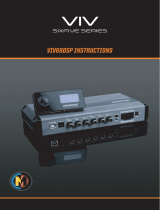ADVANCED MANUAL / Bit One
12
MAIN PAGE - DSP setting
CROSSOVER FILTER
1. The LINKWITZ or BUTTERWORTH fi lter crossover, available separately for the LEFT and RIGHT system.
STANDARD Mode (Confi g Menù): The crossover frequency between two
speakers (Lo-Hi pass) isn’t separable.
EXPERT Mode (Confi g Menù): The crossover frequency between two
speakers (Lo-Hi pass) is separable.
If the LOPASS (Woofer Left) is regulated at 300 Hz, even the
l’HIPASS (Tweeter Left) goes to 300 Hz.
If the LOPASS (Woofer Left) is regulated at 300 Hz, even the
l’HIPASS (Tweeter Left) differently.
2. XOVER-LINK Function: the crossover works on the LEFT and RIGHT channels at the same time.
If the LOPASS fi lter is selected at 300 Hz for the WOOFER LEFT, even the WOOFER RIGHT woks with the LOPASS fi lter at 300 Hz.
DELAY and PHASE
3. Select the distance in cm or in inches of each speaker (or speaker system if there is a passive crossover) in the listening
point.
For example, select the WOOFER RIGHT and fi x SET DISTANCE to 70cm. Select WOOFER LEFT and set 30cm and continue to set the
distance for the other speakers of the system. The DELAY shows the delay (in ms) the speakers nearer to the listener have, to acoustical-
ly position them at the same distance of the further speaker that has zero delay.
4. Inverts the phase of the selected speaker
If WOOFER LEFT is selected and INVERT PHASE is activated, the signal applied to the speaker has inverted polarity, to avoid the crea-
tion of a gap at the crossover frequency matching point with another speaker (for example Tweeter Left).
EQUALIZER
5. 31 band graphic equalizer.
6. EQ-LINK function: the equalizer works on LEFT and RIGHT channels at the same time.
In this way the graphic equalizer works separately on FRONT - REAR - CENTER – SUB system.
If a FRONT system speaker is selected and the equalizer is regulated, this works on all the FRONT system speakers (woofer left, woofer
right, tweeter left, tweeter right, etc)
EQ-OFF function: disactivates the equalizer (for the selected speaker), without moving the cursors.
FLAT function: resets all cursors at 0dB.
7. Buttons to move various cursors at the same time
If the buttons on 40-50-63-80 are activated, moving the cursor 80 even the other three move.
SELECT ALL function: allows the movement of all the cursors at the same time.
SPEAKERS - MUTE
8. Select the speakers to regulate, by means of the crossover, the phase, the delay and the equalizer.
EDIT shows the application of the regulations to the selected speakers.
9. Select MUTE on the speaker you want to silence, reselect to activate it.
The word lights and indicates that the selected speaker is off.
DISPLAY
10. Shows the crossover and equalizer response curve, for the selected speaker.
The RED curve is the crossover fi lter. If the equalizer changes, a green curve appears.
11. Buttons to show the crossover and equalizer response curve.
The SUM button sums the two curves and shows the signal that is sent to the selected speaker.
12. The source you are listening to.
13. To show various curves select the various speakers (8) keeping the CTRL button on the PC pushed.
To modify a speaker select EDIT near one of the writings in evidence.
The BLUE curve shows the sum of the selected speakers responses, including the equalizer.
The GREY curves show the crossover fi lter action on each speaker selected with the CTRL button.
The RED curve shows the signal and the speaker you are regulating.
MEMORIES
14. Recalls the A - B - C - D memory, to have four different setups.
To create, save, copy and manage the memories go to: Memory menù
15. Visual indicator of the listening position.
Used with the memories, it is usefull to make different setups for different listening positions.
STANDARD Mode (Confi g Menù):
works separately on FRONT LEFT - FRONT RIGHT
REAR LEFT - REAR RIGHT - CENTER - SUB.
EXPERT Mode (Confi g Menù):
works separately on every speaker.
If a FRONT LEFT system speaker is selected, for example the
WOOFER (left), and the equalizer is regulated, this works even on
TWEETER (left).
ADVANCED MANUAL / Bit One
12



















